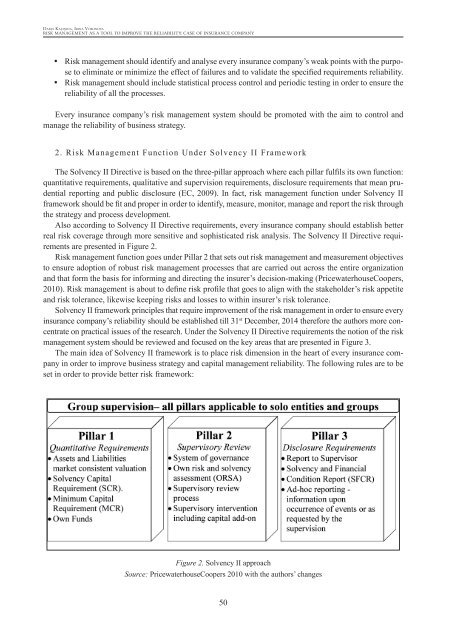regional formation and development studies - KlaipÄdos universitetas
regional formation and development studies - KlaipÄdos universitetas
regional formation and development studies - KlaipÄdos universitetas
Create successful ePaper yourself
Turn your PDF publications into a flip-book with our unique Google optimized e-Paper software.
Darja Kaļiņina, Irina Voronova<br />
Risk management as a tool to improve the reliability: case of insurance company<br />
• y Risk management should identify <strong>and</strong> analyse every insurance company’s weak points with the purpose<br />
to eliminate or minimize the effect of failures <strong>and</strong> to validate the specified requirements reliability.<br />
• y Risk management should include statistical process control <strong>and</strong> periodic testing in order to ensure the<br />
reliability of all the processes.<br />
Every insurance company’s risk management system should be promoted with the aim to control <strong>and</strong><br />
manage the reliability of business strategy.<br />
2. Risk Management Function Under Solvency II Framework<br />
The Solvency II Directive is based on the three-pillar approach where each pillar fulfils its own function:<br />
quantitative requirements, qualitative <strong>and</strong> supervision requirements, disclosure requirements that mean prudential<br />
reporting <strong>and</strong> public disclosure (EC, 2009). In fact, risk management function under Solvency II<br />
framework should be fit <strong>and</strong> proper in order to identify, measure, monitor, manage <strong>and</strong> report the risk through<br />
the strategy <strong>and</strong> process <strong>development</strong>.<br />
Also according to Solvency II Directive requirements, every insurance company should establish better<br />
real risk coverage through more sensitive <strong>and</strong> sophisticated risk analysis. The Solvency II Directive requirements<br />
are presented in Figure 2.<br />
Risk management function goes under Pillar 2 that sets out risk management <strong>and</strong> measurement objectives<br />
to ensure adoption of robust risk management processes that are carried out across the entire organization<br />
<strong>and</strong> that form the basis for informing <strong>and</strong> directing the insurer’s decision-making (PricewaterhouseCoopers,<br />
2010). Risk management is about to define risk profile that goes to align with the stakeholder’s risk appetite<br />
<strong>and</strong> risk tolerance, likewise keeping risks <strong>and</strong> losses to within insurer’s risk tolerance.<br />
Solvency II framework principles that require improvement of the risk management in order to ensure every<br />
insurance company’s reliability should be established till 31 st December, 2014 therefore the authors more concentrate<br />
on practical issues of the research. Under the Solvency II Directive requirements the notion of the risk<br />
management system should be reviewed <strong>and</strong> focused on the key areas that are presented in Figure 3.<br />
The main idea of Solvency II framework is to place risk dimension in the heart of every insurance company<br />
in order to improve business strategy <strong>and</strong> capital management reliability. The following rules are to be<br />
set in order to provide better risk framework:<br />
Figure 2. Solvency II approach<br />
Source: PricewaterhouseCoopers 2010 with the authors’ changes<br />
50

















